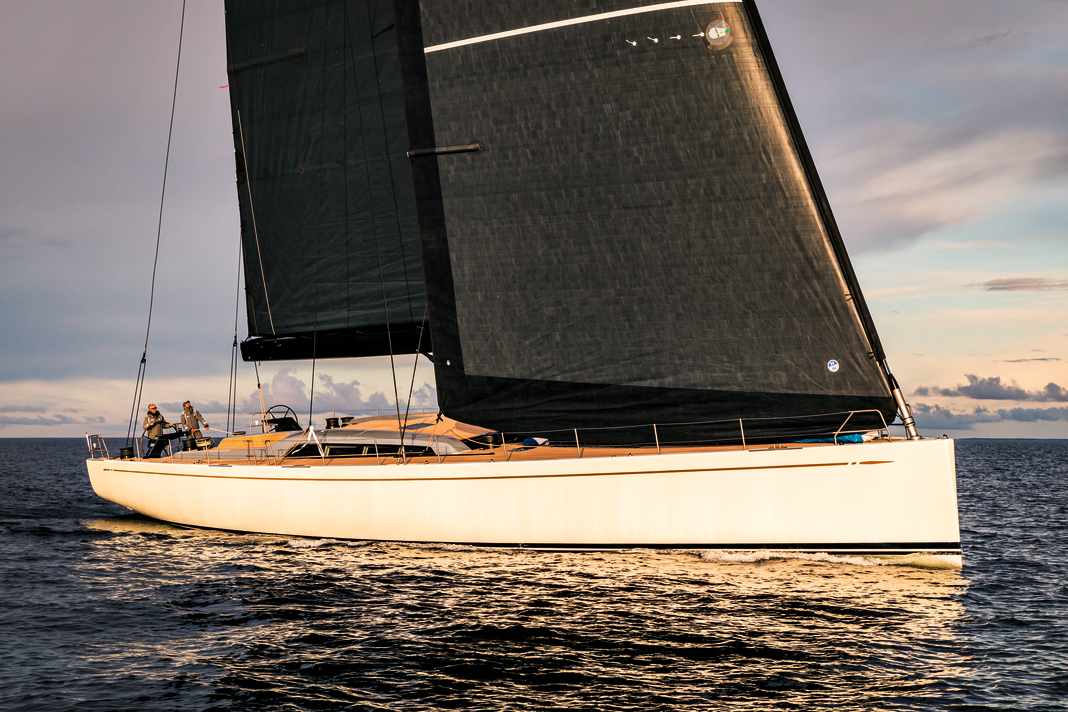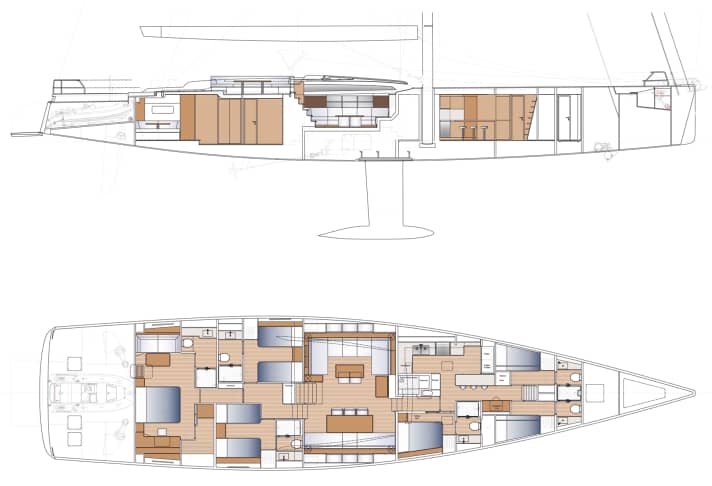





The name Nautor Swan has always been synonymous with quality, style and the best sailing characteristics. This reputation became even stronger when Italian fashion magnate Leonardo Ferragamo took the helm in 1998 and turned the shipyard in Jakobstad, Finland, into a brand. Ferragamo introduced the ClubSwan line and tied owners even more closely to the company through meetings in the Mediterranean. The extent of the customers' trust in the Finnish yacht building skills and the Italian management is demonstrated by an unusual fact for the construction of large series yachts: the first three units of the Swan 98 were sold long before the ballast bomb of the first construction number hit the water.
"With the 98, we are strengthening our position in the maxi world. This is where we belong and where we can offer substance, elegance and performance," said Leonardo Ferragamo during the presentation of "Be Cool" in 2020. At the time, the 98 positioned itself between the 120 and the new one presented in December 2020 Swan 88. In 2023, the Swan 108 In the spring of 2025, the Finns added the first Swan 128 a new flagship in the Bottenwiek. The maxis are part of Nautor's overarching "Swan" cruising line. Designed for fast cruising and blue water sailing, the Frers cracks start at 48 feet.
The Swan 98 is modern yet timeless
Designer Germán Frers gave the 98 timeless lines. The Argentinian has been shaping the Swans for over 40 years and rethought the maxi design for the 29.60 metres. "The maxis present us with different challenges: The speeds are higher, they hit waves with greater force. We tried to increase comfort by giving the 98 a relatively deeper underwater hull," says Frers, describing the difference between the 98 and the smaller Swan models. The "Maestro", as he is known internally at Nautor, designed a modern hull with a wide, yet slightly constricting stern. Whereby "Be Cool" emphasises the elegant shape particularly well. By dispensing with a gennaker nose and the four originally planned hull windows, you could almost think that the owner was afraid of embellishment.
The "Be Cool" is remarkably light
A displacement of just over 62 tonnes speaks for high competitiveness in regattas - a value achieved by many custom formats of comparable size. The reason: Nautor laminates the Corecell cores of the hull and deck internally and externally with prepreg carbon mats and leaves the epoxy resin in the mould used for the ClubSwan 125 built 46 metre furnace at 70 degrees. In this way, the BTC (Boat Technology Centre) in the north of the Gulf of Bothnia produces composite works with maximum structural rigidity at the lowest possible weight, ensuring safety and reliability.
The deck of "Be Cool" is adorned with teak rods laid parallel to the centre line, which also extend over the roof of the silver-grey superstructure. The sprayhood is integrated into this, while the bimini and awning on the twelve-metre-long boom provide shade. Frers took the characteristic cockpit coaming with exposed outer seating area from the Swan 78.
Regatta-ready equipment
For the working cockpit, the decision was made in favour of the regatta version, where each crew member sits at their own trimming station. The nine hydraulically operated deck winches from Harken include two for the forecastles. Dedicated hydraulic cylinders enable fast tacking at the touch of a button, even when the crew sets the second mainsail with the top extended on the Southern Spars mast, which extends almost 43 metres into the air. The 268 square metre standard mainsail then disappears into the forepeak.
If the crew also hoists the gennaker, the minimally overlapping 220 square metre genoa is also stored here. In the surf, the foresail bag can then also claim the aft cockpit for itself. The lazarette, in which a tender up to four metres long is parked, offers additional storage space. At the owner's request, Nautor ordered the standing rigging from Future Fibres, who supplied an aerodynamically optimised carbon package from the Aerosix series. Due to the lack of a bowsprit and the upright stem, the anchor arm swings forwards.
Traditional below deck
Even though there are no longer any different deck configurations, Nautor pursues an even stronger semi-custom approach inside the Maxis. There is a great deal of customisation below deck, partly because the shipyard only uses telescopic keels as an alternative to the fixed 4.40-metre keel from "Be Cool".
The interior design of "Be Cool" is based on the "Traditional Navy" interior world, in which Misa Poggi uses navy blue colours and taupe-coloured linen and cognac-coloured leather panelling for the walls. Instead of the originally planned teak, European oak wood is used extensively: on the floor as a floral veneer and on the walls as a sliced veneer, partly in vertical bar form.
The saloon on the 98 is also extremely bright, illuminated by three skylights in addition to the side windows and the windscreen of the superstructure. On the port side, a coffee table with recessed storage compartments becomes a pouf when closed. When this is pushed up against the sofa, a large day bed is created with the best view of the retractable television. Up to four director's chairs can be placed at the two unfolded tables.
The arrangement under the saloon speaks in favour of the soundproofing of the engine compartment. A Cummins drive unit with 224 kilowatts of power and a 20 kilowatt generator from Northern Light work here.
Photos instead of windows
Of course, the cabins on "Be Cool" are much darker than the saloon due to the lack of hull windows. This is partially compensated for by backlit photographs, which are particularly pleasing to the eye in the owner's suite. In the cabin furthest aft, which is just under six metres wide, there is space for a desk and dressing room to starboard as well as a sofa with an adjacent bathroom opposite. A companionway takes the owner into the aft cockpit at the level of the port steering wheel. The crew can add Pullman beds to the two double cabins in front if required. The guest cabin, which is located in front of the saloon and at galley level, is somewhat smaller.
Technical data Swan 98 "Be Cool"

- Overall length: 29.60 m
- LWL: 26.63 m
- Width: 6.97 m
- Draught: 4.40 m
- Displacement (empty): 62,5 t
- Ballast: 22.0 tonnes
- Material: Prepreg carbon
- Engines: 1 x Cummins QSB6.7
- Engine power: 1 x 224 kW
- Rig: Southern Spars, carbon fibre
- Standing crop: Future Fibres Aerosix
- Sails: North Sails
- Sail area (downwind): 488 m²
- Winches: Rake
- Generators: 1 x Northern Light 20 kW
- Bow thruster: Side Power SRHP300TC
- Navigation: B&G
- Naval Architecture: Germán Frers
- Exterior design: Germán Frers
- Interior design: Misa Poggi
- Shipyard: Nautor Swan, 2020

